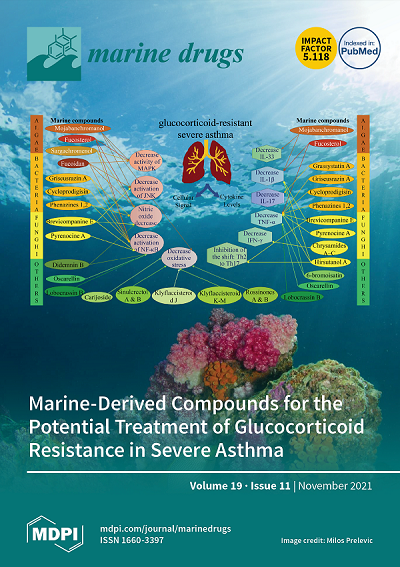Mixotrophic Cultivation of Arthrospira platensis (Spirulina) under Salt Stress: Effect on Biomass Composition, FAME Profile and Phycocyanin Content
IF 4.9
2区 医学
Q1 CHEMISTRY, MEDICINAL
引用次数: 0
Abstract
Arthrospira platensis holds promise for biotechnological applications due to its rapid growth and ability to produce valuable bioactive compounds like phycocyanin (PC). This study explores the impact of salinity and brewery wastewater (BWW) on the mixotrophic cultivation of A. platensis. Utilizing BWW as an organic carbon source and seawater (SW) for salt stress, we aim to optimize PC production and biomass composition. Under mixotrophic conditions with 2% BWW and SW, A. platensis showed enhanced biomass productivity, reaching a maximum of 3.70 g L−1 and significant increases in PC concentration. This study also observed changes in biochemical composition, with elevated protein and carbohydrate levels under salt stress that mimics the use of seawater. Mixotrophic cultivation with BWW and SW also influenced the FAME profile, enhancing the content of C16:0 and C18:1 FAMES. The purity (EP of 1.15) and yield (100 mg g−1) of PC were notably higher in mixotrophic cultures, indicating the potential for commercial applications in food, cosmetics, and pharmaceuticals. This research underscores the benefits of integrating the use of saline water with waste valorization in microalgae cultivation, promoting sustainability and economic efficiency in biotechnological processes.盐胁迫下螺旋藻的混养栽培:对生物量组成、FAME 特征和植物花青素含量的影响
板蓝根节肢动物(Arthrospira platensis)生长迅速,能够产生宝贵的生物活性化合物,如植物花青素(PC),因此有望应用于生物技术领域。本研究探讨了盐度和啤酒厂废水(BWW)对 Platensis 节肢动物混养培养的影响。利用 BWW 作为有机碳源和海水(SW)作为盐胁迫,我们旨在优化 PC 产量和生物量组成。在含有 2% BWW 和 SW 的混养条件下,A. platensis 的生物量生产率得到提高,最高达到 3.70 g L-1,PC 浓度也显著增加。这项研究还观察到生化组成的变化,在盐胁迫下,蛋白质和碳水化合物水平升高,这与使用海水的情况类似。使用 BWW 和 SW 进行混养也影响了 FAME 的分布,提高了 C16:0 和 C18:1 FAMES 的含量。混养培养物中 PC 的纯度(EP 值为 1.15)和产量(100 毫克/克-1)明显更高,这表明其在食品、化妆品和药品方面具有商业应用潜力。这项研究强调了在微藻类培养过程中将盐水的利用与废物价值化相结合的益处,促进了生物技术过程的可持续性和经济效益。
本文章由计算机程序翻译,如有差异,请以英文原文为准。
求助全文
约1分钟内获得全文
求助全文
来源期刊

Marine Drugs
医学-医药化学
CiteScore
9.60
自引率
14.80%
发文量
671
审稿时长
1 months
期刊介绍:
Marine Drugs (ISSN 1660-3397) publishes reviews, regular research papers and short notes on the research, development and production of drugs from the sea. Our aim is to encourage scientists to publish their experimental and theoretical research in as much detail as possible, particularly synthetic procedures and characterization information for bioactive compounds. There is no restriction on the length of the experimental section.
 求助内容:
求助内容: 应助结果提醒方式:
应助结果提醒方式:


